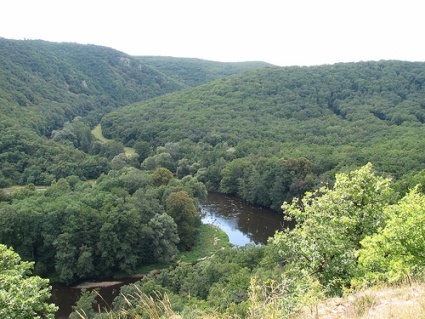

Constructed: South Moravian Region Map
Area: 63 km² (24 sq mi)
Podyjí National Park, nestled in the South Moravian Region of the Czech Republic, is the smallest and youngest of the country's four national parks, renowned for its exceptionally well-preserved river valley ecosystem. Bordering Austria's Thayatal National Park, the two form a unique transboundary "Inter-National Park" that protects a continuous natural landscape along the Dyje (Thaya) River. Covering a core area of 63 square kilometers (24 sq mi) with an additional 29 square kilometers (11 sq mi) buffer zone, it spans elevations from 214 to 534 meters (702 to 1,752 ft) and is centered around coordinates 48°51′N 15°54′E. This park is celebrated for its near-natural forests, diverse habitats, and status as one of Central Europe's most ecologically significant sites, often described as a "wild piece of Czech nature" with minimal human intervention. Its unique river canyon, lush woodlands, and rare species make it a haven for biodiversity, while its proximity to towns like Znojmo and Vranov nad Dyji enhances its appeal as a less-crowded alternative to more famous Czech natural areas.
The establishment of Podyjí National Park traces back to efforts in the late 20th century to safeguard the Dyje River valley from development and environmental degradation. Officially declared on July 1, 1991, by Czech government order no. 164/1991, it became the only national park in Moravia and the smallest in the republic. Prior to its protection, the area had been influenced by historical land use, including logging on the upper plateaus that converted forests to arable land, but the deep valley remained largely untouched due to its inaccessibility. The park's creation was driven by recognition of its unique biome, leading to joint conservation initiatives with Austria's Thayatal National Park, established in 2000, to form a cross-border protected zone. Managed by Správa NP Podyjí, the park has seen ongoing developments, including the appointment of a new director, Pavel Müller, in February 2025, to oversee conservation and visitor management. Its history also ties into regional viticulture, with areas like Šobes featuring some of the oldest vineyards in the Czech Republic, now under consideration for UNESCO World Natural Heritage status.
Podyjí National Park features a dramatic landscape shaped by the Dyje River, which carves a 40-kilometer (25 mi) meandering valley through the Českomoravská vrchovina uplands, reaching depths of up to 220 meters (720 ft). The terrain includes thickly forested slopes, rocky outcrops, and a mix of habitats from inland wetlands to shrublands and grasslands. Geologically, the park is part of an ancient upland region with gneiss and granite formations, contributing to its rugged cliffs and diverse soil types that support varied vegetation. The river's flow creates microclimates, with warmer, drier conditions on south-facing slopes fostering unique ecosystems, while the overall area spans 15 km (9.3 mi) in length and 8 km (5 mi) in width. This geography not only provides stunning vistas but also acts as a natural barrier, preserving the area's isolation and ecological integrity.
The park's biodiversity is exceptional, hosting a rich array of flora and fauna in its near-natural state. Flora includes 77 plant species in the valley alone, with dominant forests of oak (acidophilous and temperate), hornbeam, beech, and alder, alongside perennials like cyclamen, mulleins, pasque flower, and 18 species of orchids. Riverbeds feature reed-beds and willow shrubs, while upper plateaus support grasslands. Fauna is equally diverse, with 152 bird species, including key ones like the Syrian woodpecker (Dendrocopos syriacus) and barred warbler (Sylvia nisoria), qualifying it as an Important Bird Area (IBA) by BirdLife International over 76.66 square kilometers. Mammals number 65 species, and reptiles include seven, such as the tree snake and green lizard. This variety underscores Podyjí's role as a biodiversity hotspot in Central Europe, with rare and endangered species thriving in its protected habitats.
Conservation efforts in Podyjí focus on maintaining the park's natural processes, with land designated primarily for nature protection, research, forestry, and limited agriculture. Established to preserve the area's extraordinarily valuable ecosystems, the park emphasizes minimal intervention to allow wilderness recovery, including in zones like the 254-hectare wilderness area highlighted for its resilience. Cross-border cooperation with Thayatal enhances protection against threats like climate change and invasive species. Ongoing projects include habitat restoration and monitoring, supported by its IBA status and potential UNESCO recognition for sites like the Šobes vineyards. These initiatives ensure the park remains a model of sustainable conservation in a densely populated region.
As of 2025, Podyjí National Park remains in excellent condition, attracting visitors for its serene beauty and outdoor activities while staying relatively uncrowded compared to other Czech sites. Tourism centers on hiking trails that wind through the valley, offering access to attractions like the ruins of Nový Hrádek Castle, Hardegg Castle (across the border), and Vranov nad Dyjí Chateau. Popular spots include Šobes Hill, with its 12 hectares of historic vineyards managed by Znovín Znojmo, providing scenic wine-tasting opportunities. Activities encompass cycling, birdwatching, and guided tours, with visitor rules emphasizing low-impact exploration to protect sensitive areas. The park is accessible from nearby towns, with facilities including information centers, but no on-site accommodations to preserve its wild character. Events such as nature festivals and educational programs highlight its ecological importance, drawing eco-tourists and families year-round.